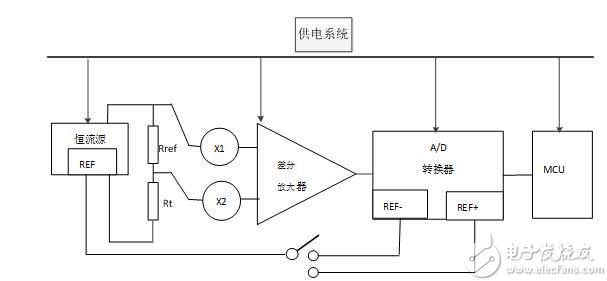High precision ADC design in temperature measurement system
Author: Yan of Shanghai Science and Technology Co., Ltd., a research agency
Foreword
There are many types of sensors for temperature measurement, including thermocouples, platinum resistance temperature detectors, thermistors, and thermal diodes.
The accuracy of the system is determined by the accuracy of the temperature sensor and the high performance ADC that digitizes the sensor's data. Many temperature measurements in industrial and medical applications typically require ±0.1 °C or better measurement accuracy, reasonable cost, and lower power consumption.
The temperature measurement range in these fields is generally between -200 ° C and +1 750 ° C. Platinum resistance temperature sensors are used in high-precision temperature measurement because of their excellent accuracy and interchangeability. Platinum resistance sensors use metal platinum. A temperature sensor in which the resistance value of (Pt) changes with temperature changes, so PRTD is generally used.
Influence of measurement accuracy
The resistance of the PRTD exhibits a nearly linear corresponding temperature measurement over the temperature range.
The PRTD temperature sensing interface can be used to provide differential signals to the ADC using 2-wire, 3-wire, and 4-wire. Each interface has its advantages and disadvantages. The 4-wire connection method can obtain the most accurate measurement results. The disadvantage is that the reliability is reduced and the system cost is increased. The 3-wire wiring is accurate and the cost is more economical. It is commonly used at present. Wiring is the most economical and usually requires the use of a microprocessor or DSP to compensate for the IR error of the leads.
The errors in PRTD measurement are mainly:
1. Error caused by wire resistance: PRTD is a kind of resistor, and the resistance of the wire between it and the control terminal causes an error.
2. Error caused by self-heating: PRTD itself is a kind of metal resistance. When the excitation current passes through PRTD, the power consumption generated causes the temperature of the sensor itself to rise, resulting in the resistance value of PRTD becoming larger.
3, PRTD linear error: PRTD has an approximate linear characteristic, the resistance is 100 ohms PRTD at 0 °C, the resistance will reach 200 ohms when the temperature reaches 266 °C, but the linearity error will change with temperature.
High precision design
Temperature measurement systems are generally low-speed, sampling no more than 100 times per second, narrow-band ADC can meet the demand, but the ADC is required to have high precision, this article on how to ensure the high precision of the ADC is as follows:
1) The Pt1000 platinum resistance is driven by a three-wire constant current source, which effectively overcomes the influence of wire resistance and self-heating effect on measurement accuracy;
2) Using the single-chip microcomputer to calculate the two measured voltages under the bipolar driving current can effectively avoid the systematic error caused by the wiring barrier voltage and the offset and drift of the amplifier and A/D converter;
3) The constant current source and the A/D converter share a reference reference, which effectively eliminates the error caused by the instability of the reference reference.
4) The MLS numerical algorithm is used to cancel the noise in the MCU, which further overcomes the influence of noise and random error on measurement accuracy and stability, and greatly improves the accuracy and stability of temperature measurement.
5) The ADC has a differential analog input and accepts a differential reference voltage for ratio configuration. As can be seen from Figure 1, the constant current source is supplied to the ADC reference. The voltage generated by the precision constant current source is supplied to the differential reference input of the ADC. The analog input voltage of the ADC is proportional to the reference voltage. Any error in the analog input voltage caused by the temperature drift of the PRTD current source can be compensated by the deviation of its reference voltage.

Figure 1 Three-wire high-precision temperature measurement system
In addition, the temperature measurement system requires high requirements for the ADC and other electronic components of the system. The tiny analog signal generated by the temperature sensor needs to be amplified by a low-noise gain amplifier, and the noise of the amplification circuit is not required to flood the weak signal of the sensor. The analog-to-digital conversion part requires a high-precision ADC to digitize the analog signal output from the sensor, and a high-precision ∑-Δ type ADC is suitable. In addition to the ADC and the amplified supply, the excitation current source and reference must have low drift and low noise to provide better system accuracy.
Dongguan Tuojun Electronic Technology Co., Ltd , https://www.fibercablessupplier.com
